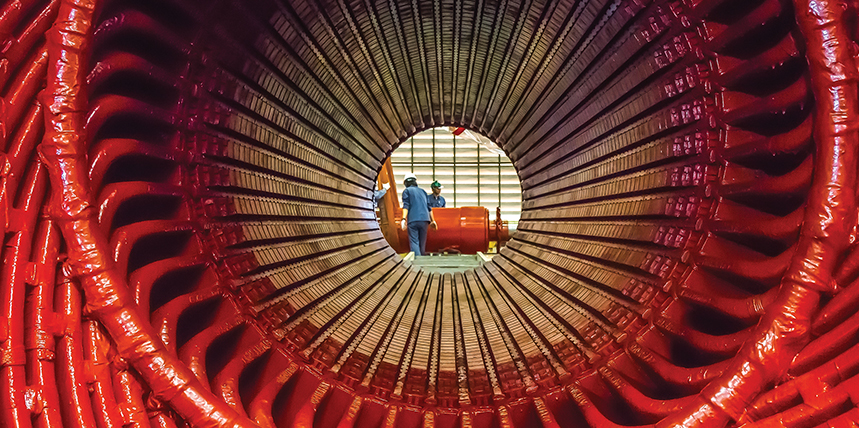Performing condition analysis or maintenance on rotating machinery is a hazardous task that requires an experienced individual who is capable of performing the duty and possesses a solid ability to identify any potential hazards and mitigate their risks.
Inadvertent injuries, such as crushed hands, arms, severed fingers, blindness, or death can occur from rotating machinery if extreme caution is not exercised. The use of lockout/tagout, personal protective equipment (PPE), and other means of safeguarding can mitigate possible injuries. Social media is full of videos showing employees who were seriously injured when they failed to use caution while working around rotating machinery.
Analyzing the condition of rotating equipment can be performed using products designed to access equipment while it is operating, including infrared survey, partial discharge detection, and vibration analysis. The PPE required for the task should be appropriate and adequate for all tasks that are to be performed. Long sleeves, long hair, jewelry, and other loose articles are an invitation for disaster when around rotating machines. Make sure sleeves are tight, hair is pulled back or tied up, and any other sources of entanglement are removed.
Any machine part, function, or process that can cause injury must be safeguarded. When operating a machine or when accidental contact with a machine can injure the operator or others in the vicinity, the hazards must be mechanically controlled or eliminated.
When visually inspecting rotating machinery, ensure all guards are properly installed per the manufacturer’s instructions and comply with OSHA 29 CFR 1910.212, General Requirements for All Machines, Subpart O, Machinery and Machine Guarding, as well as OSHA 29 CFR 1910.219, Mechanical Power-Transmission Apparatus. For Canada, refer to the Canadian Center for Occupational Safety and Health (CCOHS) regulation CSA Z432, Safeguarding of Machinery. Depending on the type of machinery being inspected, additional regulations may apply.
HAZARDS
The following paragraphs identify and examine hazards, the means of safeguarding them, and potential ways to mitigate the associated risks. This article does not include EVERY potential hazard from performing a task, but explores potential hazardous situations. Additional hazards may exist, depending upon the type or condition of the equipment. Take all procedures seriously, and verify that the instruction manuals used are specific to the equipment. Check for and identify potential hazards prior to beginning every task by using a pre-job brief worksheet.
Electrical and Mechanical Hazards
Improper lockout/tagout procedures are a major contributing factor to injuries caused by rotating machinery. Controlling the hazardous energy of the motor is essential, and many forms of energy may be involved. Always refer to the appropriate OSHA regulation or required procedure, such as 29 CFR 1910.147 and 29 CFR 1910.333 or CCOHS CSA Z460-20, Control of Hazardous Energy — Lockout and Other Methods, and the manufacturer’s instructions to determine the proper lockout/tagout or required procedure. The most obvious hazardous energy source that could cause injury to the worker is electrical. Other hazards may be harder to recognize.
Electrically de-energize rotating machinery from the primary energy source and ensure the equipment is disconnected from all sources of power, AC as well as DC, if applicable. Once de-energized, verify that the equipment is at a zero energy state using the manufacturer’s approved method. Verify the accuracy of the detection or voltage measuring device against a known source, then check for zero energy on the de-energized equipment, then test the detection equipment against a known source again. This will verify that the detection meter was functional during the check. Testing for voltage will require its own level of PPE depending upon the voltage and test procedure per NFPA, OSHA, or CCOHS.
Electrical energy isn’t the only energy that requires lockout/tagout. Rotating machinery can also contain a large amount of mechanical energy, which may not be readily obvious. This energy must be dissipated prior to servicing, or serious injury could occur to the worker. Once the energy has been discharged or dissipated, it is also advisable to lockout/tagout any charging mechanism, if feasible. Ensure that remote operating handles are tagged in a local or manual mode. This will prevent another worker from inadvertently operating the machinery.
Chemical Hazards
Machinery operating mechanisms may also be pressurized with a liquid or a gas. Ensure the unit is depressurized and/or discharged and the source of the pressure is disabled. Ensure any valves upstream or downstream of the device are closed, and lockout/tagout each valve. Once disabled, this source must also be locked out/tagged out prior to performing maintenance.
Chemicals can be a hazard, depending upon the type of rotating machinery and the process the machine is associated with. Caution must be taken with gas or liquid chemicals. Many processes produce gases that are denser than air, so the gas displaces oxygen in lower-lying areas. Ventilation must be used to avoid trapping these gasses.
Some lubricants and cleaners are a respiratory and skin irritant if used in enclosed areas or during contact with exposed skin. Knowing the material used, reading the container labeling, and checking the safety data sheet (SDS) is advised to identify any potential health effects from its use. Using proper PPE is necessary while using some cleaners and lubricants. Nitrile gloves, safety glasses, a face shield, and even respiratory protection may be needed in some cases.
Other Physical Hazards
When performing visual inspection, mechanical inspection, maintenance, or electrical testing on rotating machinery, gravity is a less-obvious form of energy that must be controlled. The size and weight of panel covers and inspection plates can make them difficult to handle. Should gravity be a potential energy source to a piece of rotating machinery, such as a drive motor for an inclined loaded conveyor belt, ensure the energy is dissipated and any flywheels or other sources of energy or moving parts are chained or locked in position prior to performing lockout/tagout and maintenance.
Human Error Hazards
Human error is a mistake someone makes. To help prevent an error, follow a procedure or checklist while performing the task. If one doesn’t exist, create one.
Nomenclature should be verified and re-verified upon approaching a piece of equipment — every time. Perform a self-check and a peer-check to ensure the task is being performed on the correct component.
Utilize markings such as flagging when working around similar-looking pieces of equipment to identify components that should not be touched. Flagging can take several forms depending upon the company or client’s policy and procedures. Do not forget to identify, mark, then lockout/tagout all associated equipment (i.e., associated cables and compartments). Flagging can also be utilized to indicate a component that is not operating normally.
Use barricades to create a safe work zone. This prevents other workers from inadvertently entering the work area. It also ensures that maintenance and testing is conducted in a controlled area. The worker should utilize a test stand in this area if applicable. Ensure any control voltage required to operate the equipment during testing is within a secured area.
PPE Hazards
After verifying that the rotating machinery is de-energized, disconnecting the equipment may require a different form or class of PPE. To ensure proper PPE is utilized for the class of disconnection methods, refer to the applicable regulatory agency for the required PPE and the hazard/risk class, which will indicate what level of protection is required. Identifying the correct level of PPE and gloves will help mitigate injury from a potential arc flash. Remember, these regulatory agencies only provide information based upon known values of the short-circuit current available, the clearing time in cycles, and the minimum working distance. If those factors are unknown, more information must be gathered prior to performing the work to ensure personnel safety.
Temporary Protective Grounds
Grounds are an excellent secondary means of protecting the worker from inadvertent energization. Refer to any applicable OSHA, CCOHS, and NFPA regulation for specific guidance on grounding locations and sizing of grounds required for the task. Grounds must always be applied upstream and downstream of the equipment and as close to the work as possible. Using correctly sized and applied grounds is an additional safeguard for employees should a form of electrical energy be introduced into the system or equipment. Induced voltage or back-feed are just two forms of energy that may be inadvertently introduced into a system that has not been properly locked out/tagged out.
CONCLUSION
There are many things to be aware of when performing maintenance and testing on rotating machinery.
- Obtain all service bulletins, maintenance documents, arc flash studies, and manuals prior to beginning work for the specific device.
- Review all prints and one-line documents associated with the equipment.
- Establish a safe work area, and barricade off the work area.
- Perform a pre-job brief with all employees on site.
- Wear proper PPE.
- Disconnect the electrical feed and control circuit(s), verify mechanical interlocks are properly engaged, and test equipment before performing visual or mechanical inspections.
- If applicable, verify that there is zero energy (test, check, test), and discharge all stored energy including pressurized gasses and gravity.
- If possible, lock out and tag out ALL energy sources.
- Connect grounds where and/if applicable.
- Identify, visually mark, and/or flag equipment being worked on.
Being aware of and mitigating these hazards can lead to a safer work environment while inspecting, maintaining, and testing rotating machinery.

Paul Chamberlain has been the Safety Manager for American Electrical Testing Co. LLC since 2009. He has been in the safety field since 1998, working for various companies and in various industries. Paul received a BS from the Massachusetts Maritime Academy.
